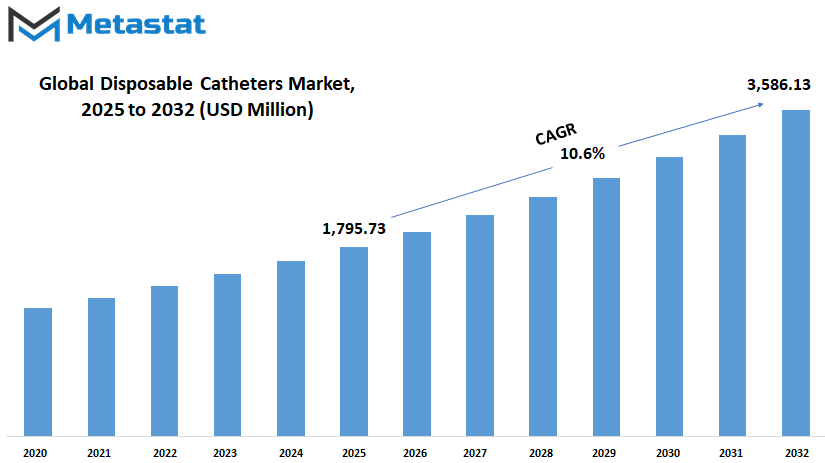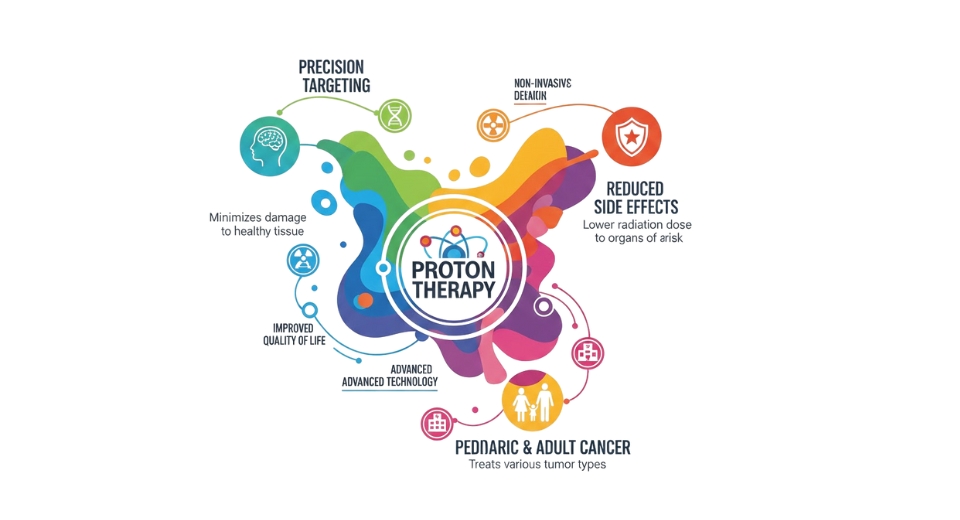MARKET OVERVIEW
The Global Disposable Catheters market and industry make up one of the most important components of the medical devices segment with only single-use catheters, designed to ensure safety, hygiene, and efficiency in various medical procedures. These catheters are important in patient treatment, as they provide sterile solutions in fluid drainage, medication delivery, and diagnostic procedures. Global Disposable Catheters will continue to be an important aspect of modern health care systems worldwide when considering the rapid increase in demand for advanced medical devices.
Disposable cathetersfind their primary use in preventing cross-contamination and infection, rendering them irreplaceables in hospitals, clinics, and home care. They cover a wide range of medical concern such as urology, cardiology, neurology, and intravenous therapy. Disposable catheters come with the advantage over reusable ones that they are pre-sterilized, thus negating the need for repeated cleaning and reducing the risk of hospital-acquired infections. Thus, this safety features makes it a favor among health care providers whose target is improved patient outcome.
The Global Disposable Catheters market will also be represented by a wide range of different products intended for various medical applications. For instance, urological catheters include intermittent and Foley catheters for bladder conditions, while cardiovascular catheters allow for minimally invasive diagnostic and therapeutic procedures. Neurovascular and specialty catheters enable the management of complex neurological disorders, thus demonstrating the broad scope of this market and its adaptability to different medical disciplines.
Technological advancement will be the factor driving product innovation in this market, leading to catheters with enhanced materials, ergonomics, and biocompatibility. Moving to disposables thus stands in line with the global emphasis on infection control and patient safety. The incorporation of some additional advanced product offerings, such as antimicrobial coatings and closed system designs, would also strengthen the market to cater to changing requirements of health care.
The Global Disposable Catheters market covers geographical regions such as North America, Europe, Asia-Pacific, Latin America, and the Middle East and Africa. Each region bears with it a distinct healthcare use infrastructure and regulations and patient demographics which impacts market dynamics and the state of product adoption. The market's global visibility manifests itself in its ability to meet varied requirements of medicine and the global need for secure and effective catheterization solutions.
Rising healthcare costs and an increasing burden of chronic illness that may require long-term catheterization, along with increasing surgical procedures, will be some of the factors that will define the growth of this market in the coming years. Also, the contribution of disposable catheters in reducing infection rates and improving procedural efficiency will only fortify their cause further .
Global Disposable Catheters market is estimated to reach $3,586.13 Million by 2032; growing at a CAGR of 10.6% from 2025 to 2032.

GROWTH FACTORS
Rising prevalence of urinary incontinence as well as chronic ailments remain among other drivers. Aging of the global population has made conditions like diabetes, neurological disorders and poor urological health common. These constant health problems need management over long periods, with catheters serving to get comfort and quality healthcare for the patients in need of prolonged catheterization. Although there may be increasing numbers of people suffering from these health conditions, increasing numbers directly push demand for disposable catheters.
Other significant contributor to the growth of the disposable catheters market has been the increasing preference for single-use devices to avert infections. Single-use catheters minimize the risk of cross-contamination and hospital-acquired infections and are therefore a safer option to reusable ones. With a growing focus on patient safety and hygiene, the adoption of single-use catheters has gained a stronger foothold around the world. This transition would not only reduce infection rates but also improve the general efficiency of the delivery of healthcare services by such products, as disposables eliminate the need for elaborate sterilization procedures.
Nevertheless, a positive market entry may be hampered by challenges. A major concern involves high costs associated with frequent catheter replacements. For other patients in long-term catheterization, disposable catheters may eventually incur major expenses. This cost may act as an impediment, especially in areas where healthcare funding and insurance coverages are somewhat limited.
Environmental concerns regarding medical plastic waste disposal also pose a challenge. The widespread use of disposable medical devices contributes to the growing volume of non-biodegradable waste, raising sustainability issues. As the healthcare sector strives to balance safety with environmental responsibility, the demand for more eco-friendly alternatives is becoming increasingly important.
However, advancements in technology are expected to address some of these challenges and open new opportunities for the market. Innovations in biodegradable and antimicrobial catheters offer promising solutions for both environmental and safety concerns. Biodegradable options help reduce plastic waste, while antimicrobial coatings minimize the risk of infections even further. These advancements align with the global push for sustainable and patient-centric healthcare solutions.
Owing to necessity in medicine, priorities regarding safety will give room for continuance in growth within the Global Disposable Catheters Market in the coming years, Innovations towards the reduction of costs and environmental implications shall be horizons for further market development towards which safety and excellence would stand shot.
MARKET SEGMENTATION
By Type
The Global Disposable Catheters market will continue to be driven by improvements in healthcare and hygiene education that will present increasing opportunities for efficient medical equipment. Disposable catheters are becoming more preferred as demand rises for better patient care because these devices minimize the risk of infections and are more comfortable. These catheters keep an appliance on the consumption aspect into which high standards of safety and hygiene have been built so as to ensure that medical procedures remain safe and clean. The use of disposable catheters will keep increasing as medical technologies evolve and as patient numbers continue to increase.
This is the factor that is currently dominating the market-the increase in the number of chronic disease patients requiring long-term catheterization. Conditions like urinary incontinence lead to the need for catheters, as do neurological and urological disorders. Hence, the need for availability and quality conditions in the use of a catheter. Disposable catheters make a good solution, as they contribute to lessening the risk of cross-contamination and other types of hospital-acquired infections. Also, the trend in the healthcare industry is moving towards patient-friendly and infection-free products, which makes them the go-to solution.
The Glocal market is a Global Disposable Catheters market that comprises every type of catheter for special medical needs. Intermittent catheterization is a short-term drainage procedure whereby an indwelling catheter is inserted and removed several times during the day. They provide the best conditions for patients who can administer self-catheterization and also help to reduce long-term complications. On the other hand, the Foley or indwelling catheters are for continuous drainage, which can be retained for longer periods. These catheters find wide usage in hospitals in case of constant monitoring and draining in some patients. External catheters are those that are attached externally on male patients and can thus provide a non-invasive solution which makes use of this procedure very comfortable and easy without the need for internal insertion.
Going forward, breakthroughs in technology are likely to define the future direction of the market. Innovations in design, comfort, and safety of disposable catheters will increase their recyclability even further. These will most often entail the incorporation of antimicrobial coatings on catheter surfaces and development of more advanced materials that cause less irritation and infection. At the same time, there is a growing demand for ready-to-use disposable catheters home healthcare and patient independence have gained importance.
As healthcare systems develop more robust safety and efficiency case protocols, so will the global disposable catheter market stand to benefit improvements in patient care. Continuous innovation and awareness will ensure that these medical devices remain relevant in effective means of addressing a wide range of medical needs.
By Material
This disposable catheter market is an escalating one on an international scale in the coming years with developments in the threat of increase in demand in the field of safe and hygienic medical devices. Consequently, infection avoidance among patients as well as their safety has become the primary focus as healthcare systems advance. Disposable catheters are used for single use and play an important role in minimizing the risks of cross-contamination. They are supposed to find more and more employment across hospitals, clinics, and home-care services on their way to high-quality standards in health care. An increase in the patient population needing long-term catheterization is expected to drive growth in the demand for such medical apparatus due to the rising prevalence of chronic diseases.
Several factors such as the types of materials used in the manufacturing of disposable catheters usually drive major changes in the market for Global Disposable Catheters. The present market is basically divided into latex catheters, silicone catheters, and rubber catheters. Each one proves to have its own merits based on varied medical requirements and preferences by the patients. Latex catheters are widely acknowledged for a flexible and inexpensive approach.
They are mostly considered when the need for short-term use arises to provide comfort for the patient and ease of insertion. Instead, silicone catheters have become the alternative choice because of their effect due to allergy that is elicited in some patients. These catheters are engineered with biocompatibility and resistance to encrustation. Less frequent replacements owing to less irritation make these catheters very useful in their brand of long-term application. Strength and elasticity are ascribed to rubber catheters; therefore, they prove to be reliable in any medical procedure where some flexibility and resilience are required.
As a future expectation, it may be that material advancements will lead innovations in the Global Disposable Catheters market. Work is already being done on catheters with forms to increase comfort, antimicrobics, and durability. With a growing concern for patient-centric care, unmet needs will very well change into demand for customized solutions for particular medical conditions. Furthermore, the coming technology into practice for example smart technology (sensors for monitoring catheter usage or complication detection) opens a new epoch in catheter handling and usage.
In an expanding old population, the increase in the number of cases of diseases, such as urinary incontinence, cardiovascular diseases, and neurological disorders, would fuel the growth of the market. This means that as more individuals require long-term medical support, the demand for reliable and safe disposable catheters will continue growing. Products are likely to be available more conveniently, with less risk of infection and more comfort for patients.
By Application
The Global Disposable Catheters market is going to witness remarkable growth in the years to come, owing to the increasing demand for advanced medical devices and the rising awareness of health and hygiene. The growing evolution of healthcare has spotlighted the urgency of disposable catheters. These single-use medical devices help lower the risk of infections, making them more desirable than reusable ones. The steady increase in the prevalence of various medical conditions, along with patient safety concerns, is likely to create further growth in the disposable catheters market.
One factor driving this growth is the increasing cases of urinary incontinence. This common problem can occur at any age, but it is seen more often in the elderly. This handy device creates a hygienic solution for the patients, providing comfort for themselves while minimizing their chances of infection. A higher demand for these medical devices in the coming years will evolve with an aging population and higher life expectancy. There are likely to be continued advances in catheter design and materials, contributing to a better patient experience and further popularity.
Benign Prostatic Hyperplasia (BPH) is yet another ailment contributing to the expansion of the Global Disposable Catheters market. This is, in fact, a common health problem in the older male population, leading to urination problems that often may require catheterization. Disposable catheters provide for an applicable and safe means to alleviate the symptoms presented by the BPH, minimizing the risk of complications due to long-term catheterization. As public awareness of BPH increases and more people seek treatment for it, demand for disposable catheters in the management of BPH may increase.
Spinal cord injury is one of the very important influencing factors for the Global Disposable Catheters market. These patients usually find it difficult to control their bladder and thus require daily catheterization as part of their management. Disposable catheters serve as the sanitary and convenient option for these patients, thus improving their quality of life and preventing infections. With the advances in medical technology and more efficacious treatment options developed in future, these catheters are going to be in heightened demand because such developments would facilitate patient comfort and safety.
In addition, general surgery offers another crucial application for disposable catheters. Catheterization is often required around the time of surgery for the drainage of fluids and to monitor recovery after surgery. The use of disposable catheters ensures that a sterile environment is maintained, thus minimizing the risk of post-operative infection. As surgical techniques advance and the volume of surgeries increases globally, demand for disposable products is going to do the same.
By End-Users
The Global Disposable Catheters market is expected to grow significantly in the coming years due to advancements in medical technology and the increasing need for efficient healthcare solutions. Catheters play a crucial role in patient care, providing essential support for various medical conditions. As healthcare systems worldwide continue to evolve, the demand for disposable catheters is likely to rise, driven by the need for safer, more hygienic, and cost-effective medical devices.
One of the primary factors influencing this market’s growth is the increasing preference for disposable medical devices. Unlike reusable ones, disposable catheters reduce the risk of infection, making them a safer option for both patients and healthcare providers. This safety aspect is especially important in healthcare environments where maintaining strict hygiene standards is essential. As more hospitals and clinics prioritize patient safety, the shift towards disposable catheters will likely accelerate.
The Global Disposable Catheters market is categorized based on end-users, which include hospitals, clinics, ambulatory surgical centers, and home care settings. Hospitals are expected to remain one of the largest consumers of disposable catheters due to the high volume of patients and the variety of procedures requiring catheterization. With the increasing number of surgeries and inpatient treatments, hospitals will continue to rely on disposable catheters to maintain high standards of care and prevent cross-contamination.
Clinics also play a significant role in the demand for these medical devices. As outpatient services expand and more patients seek treatment for chronic conditions, the use of disposable catheters in clinics is expected to rise. These settings require efficient and safe medical tools for diagnostic and therapeutic procedures, making disposable catheters a preferred choice.
Ambulatory surgical centers, known for their focus on same-day surgical care, are another key end-user group. These centers emphasize efficiency and patient safety, and the use of disposable catheters helps maintain sterile environments while streamlining operations. As these facilities become more popular due to their convenience and cost-effectiveness, their demand for disposable catheters is likely to grow.
Home care settings represent a growing segment in the market, driven by the increasing number of patients managing long-term health conditions from home. Disposable catheters offer ease of use and reduce the need for frequent hospital visits, providing patients with greater comfort and independence. With the rise of home-based care, this segment will continue to contribute to the market’s expansion.
Looking ahead, technological advancements and the growing emphasis on patient safety will shape the future of the Global Disposable Catheters market. Innovations in design, materials, and functionality will improve patient experience and treatment outcomes, ensuring that disposable catheters remain an essential part of modern healthcare.
|
Forecast Period |
2025-2032 |
|
Market Size in 2025 |
$1,795.73 million |
|
Market Size by 2032 |
$3,586.13 Million |
|
Growth Rate from 2025 to 2032 |
10.6% |
|
Base Year |
2024 |
|
Regions Covered |
North America, Europe, Asia-Pacific, South America, Middle East & Africa |
REGIONAL ANALYSIS
rising population density, and burgeoning economies, which steadily emerge as saline and effective channels, have been a boon and drastically increase scope for creating innovative applications of generating and cultivating practical use resources.
North America comprises the United States, Canada, and Mexico, and collectively these countries stand out as they not only have well-established healthcare systems but also great adoption of advanced medical technologies. The demand for catheters disposables has increased in the region most likely as a result of the campaigns against hospital-acquired infection, and the high investment in research and development will further augment it as well as the aging population that is increasingly requiring long-term care.
Some good news from this expect region: Europe, comprising the UK, Germany, France, Italy, and so on, is anticipated to be another significant growing market. This is because the regional emphasis on high-quality patient care and stringent healthcare regulations are expected to propel the usage of disposable medical devices even more. Countries like Germany and the UK will probably be ahead in innovation and adoption because of their advanced healthcare infrastructure, while the increased hygiene and safety awareness in the emerging region will further add to the demand.
The Asia-Pacific region comprises countries like India, China, Japan, South Korea, and a few others. These countries offer great scope for market growth. Rapid urbanization, increasing healthcare expenditure, and a rise in the number of medical procedures are some of the factors contributing to the growing demand for disposable catheters. Key drivers will be populous countries such as China and India, which are improving health facilities for their citizens. Additionally, action towards improved infection control practices and demand for inexpensive and high-performance medical devices are expected to reflect the shape of the market at this level.
The region of South America, including Brazil, Argentina, and the surrounding nations, is thought to see the improving healthcare systems and the growing awareness towards infection prevention, where it will fast grow. Countries like Brazil, with the current investment mobilization in medical infrastructure and improving patient care, are set to fuel the growth of their market regionally. Demand for low-cost, high-quality medical devices will be the mainstay for market growth.
It would also mean potential growth opportunities from the Middle East-Africa region, which includes the GCC or other countries like Egypt, South Africa, and the rest of the countries in the area. Expanding healthcare facilities and increased government initiatives to improve medical care within these countries, coupled with a growing focus on hygiene standards, are underlining the demand for disposables in catheters. Emerging regional markets in this respect such as South Africa and those in the GCC are expected to become part of prominent players in adopting advanced devices for medical applications.
As health systems around the world progress and catch up with one another, dynamically changing, the world will see changes in the disposable catheters market from one region to another in the near future, influenced by technological improvements, rising awareness, increases in population density, and swaying economies making progressive strides in determining and setting up saline and effective channels.

COMPETITIVE PLAYERS
The Global Disposable Catheters market is expected to witness significant expansion during the coming times owing to advances in medical technology and demand for better efficiency and safety in healthcare offerings. Disposable catheters are becoming an integral part of patient care; they present convenience to the patient and pose less risk of infection compared to reusable ones. With an increasing number of patients suffering from chronic illnesses, the need for better facilities will invariably translate into higher demand for disposable catheters. The enormous potential of this market has incited several firms, which are trying hard to come up with innovative and high-end products to cater to global needs.
The other major issue that will likely keep funding and innovations in the Global Disposable Catheters market will be technological advancement. Newer, better, and more efficient materials and designs will assuredly make these devices more effective, comfortable, and safe for the patient. The thrust in research and development will be to minimize the risk of getting infected as well as to make these devices pretty easy to handle. The market will also benefit from an increasing aging population worldwide and increased prevalence of conditions requiring catheterization, such as urinary disorders and cardiovascular diseases. Demand for single-use medical devices, which are hygienic and safe for the patient, will only reinforce this trend.
With increasing competition in this market, a few key players have begun to establish their leadership by emphasizing quality, innovation, and accessibility. Coloplast A/S, B. Braun Melsungen AG, Boston Scientific Corporation, and Teleflex Incorporated are heavily involved in the research and development of new disposable catheters that encompass both patient comfort and safety. All of these companies are working towards developing easy to handle, efficient devices that will reduce complications. In contrast, companies such as Hollister Incorporated, Cook Medical, and ConvaTec Group PLC are concentrating on expanding their presence through effective distribution systems to ensure that their products reach a wider market.
In addition, Cardinal Health, Inc., Becton, Dickinson, and Company (BD), and Terumo Corporation are all actively participating in determining the market's future. They intend to do this by enhancing strategic collaborations, research initiatives, and product innovations to stay ahead of market demands while providing healthcare professionals with reliable and advanced tools. The competition among the companies towards innovation will lead to enhancement of their product offerings, hence triggering even further innovations in safety, efficiency, and comfort in the market.
Disposable Catheters Market Key Segments:
By Type
- Intermittent Catheters
- Foley/Indwelling Catheters
- External Catheters
By Material
- Latex Catheters
- Silicone Catheters
- Rubber Catheters
By Application
- Urinary Incontinence
- Benign Prostatic Hyperplasia (BPH)
- Spinal Cord Injuries
- General Surgery
By End-Users
- Hospitals
- Clinics
- Ambulatory Surgical Centers
- Home Care Settings
Key Global Disposable Catheters Industry Players
- Coloplast A/S
- B. Braun Melsungen AG
- Boston Scientific Corporation
- Teleflex Incorporated
- Hollister Incorporated
- Cook Medical
- ConvaTec Group PLC
- Cardinal Health, Inc.
- Becton, Dickinson and Company (BD)
- Terumo Corporation
WHAT REPORT PROVIDES
- Full in-depth analysis of the parent Industry
- Important changes in market and its dynamics
- Segmentation details of the market
- Former, on-going, and projected market analysis in terms of volume and value
- Assessment of niche industry developments
- Market share analysis
- Key strategies of major players
- Emerging segments and regional growth potential








 US: +1 3023308252
US: +1 3023308252






